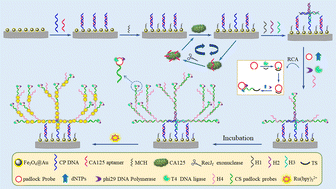Ultrasensitive detection of CA125 based on a triple signal amplification strategy with a huge number of loaded probes via exonuclease cyclic cleavage, rolling cyclic amplification and strand self-growth
Abstract
A novel electrochemiluminescence (ECL) aptamer biosensor with high sensitivity and selectivity for the detection of tumor biomarker carbohydrate antigen 125 (CA125) was constructed, and a strategy of triple amplification of signals was proposed using an exonuclease cyclic cleavage aptamer, combined with rolling ring amplification technologies, generating multi-branched dendritic double-stranded DNA to load a large number of probes through “strand self-growth”. The double-stranded DNA, which is abbreviated as CP/CA dsDNA, formed by hybridizing the single strand of capture DNA (CP DNA) with the single strand DNA of the CA125 aptamer (CA Apt) was modified on Fe3O4@Au. When CA125 was added, CP/CA dsDNA was unwound, and CA125 specifically combined with CA Apt to form a protein–aptamer complex, leaving only CP DNA on the surface of Fe3O4@Au. RecJf exonuclease cleaved the aptamer in the protein–aptamer complex and released CA125, which recombined with other CA125 aptamers, to form a cycle that produces more CP DNA on Fe3O4@Au. Three ssDNA (H1, H2, and H3) were introduced and hybridized with CP DNA to form a dsDNA with a “+” configuration structure. Then phi29 DNA polymerase, T4 DNA ligase, deoxy-ribonucleoside triphosphate (dNTP) and padlock probes were added to form a large number of complementary strands of padlock probes (CS padlock probes) by rolling cyclic amplification. CS padlock probes were linked to the “+” type dsDNA; then ssDNA H4 was added and hybridized with the CS padlock probe to form multi-branched dendritic dsDNA. A large number of tris(2,2′-bipyridyl)ruthenium(II) probes were embedded in the double strands, resulting in an extremely strong ECL signal in the presence of the co-reactant tri-n-propylamine (TPA). There is a linear relationship between the ECL signals and CA125 concentrations in the range of 1.0 × 10−15–1.0 × 10−8 mg mL−1, and the detection limit was 2.38 × 10−16 mg mL−1. It has been used for the determination of CA125 in serum samples.

- This article is part of the themed collection: Analyst HOT Articles 2023


 Please wait while we load your content...
Please wait while we load your content...